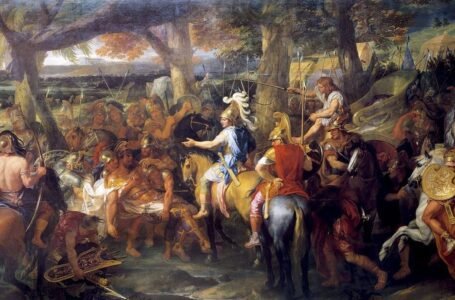Echoes of the Ancients:The Rosetta Stone and the Allure of Egyptomania
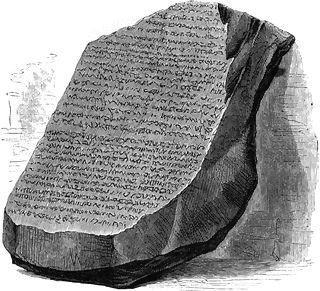
Ancient Egypt with its unparalleled pyramids, the mysterious Sphinx, intriguing artefacts and captivating Hieroglyphs has fascinated millions ever since modern archaeology started revealing these monuments and artefacts oftentimes millenia old to the general public at large. But the inability of researchers and historians to decipher the Hieroglyphics proved to be a huge challenge in truly understanding the history, culture and civilisation of ancient Egypt. Historians all over the world were puzzled by this unique creation and scrambled to find a key that would unlock the rich history of Egypt. This much anticipated key was the Rosetta stone, which was discovered at the turn of the 18th century, in 1799.
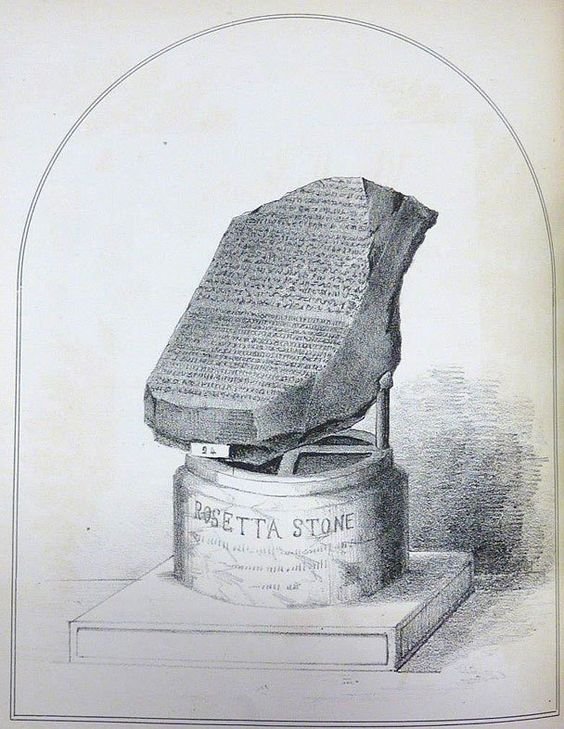
Today, the Rosetta Stone is rightly considered a great milestone in the study of ancient languages and scripts. Pierre-François Bouchard was the French soldier who was responsible for its discovery during Napoleon Bonaparte’s military campaign in Egypt. In 1798, Napoleon was aiming to disrupt British trade routes to India and increase French influence in the Mediterranean.
Initially, the campaign saw military success, with French forces swiftly defeating the Mamluk rulers in battles such as the Battle of the Pyramids. But soon, guerrilla warfare tactics employed by local Bedouin tribes and the British naval victory at the Battle of the Nile in 1798, effectively cut off French supply lines and isolated them in Egypt. Regardless, this Campaign was very essential for the sphere of History since it sparked a renewed interest in Egyptology and ancient Egyptian culture in Europe.

The Moment of Discovery: As part of the expedition, a group of 167 technical experts, known as the Commission des Sciences et des Arts, accompanied the French army to Egypt. Their mission was to study and document the country’s ancient monuments, culture, and natural resources. On the 15th of July 1799, while French soldiers, led by Colonel d’Hautpoul, were fortifying the defences of Fort Julien near the port city of Rosetta, Lieutenant Pierre-François Bouchard made a remarkable discovery. Among the rubble, Bouchard noticed a slab with unique inscriptions. This slab bore inscriptions in three scripts: ancient Egyptian hieroglyphs, Demotic script, and Ancient Greek. Recognizing its potential significance, Bouchard immediately brought it to the attention of his superiors.
Bouchard swiftly transported it to Cairo for further examination by scholars. As the news of the discovery spread, the stone began to be referred to as “la Pierre de Rosette”. Amidst the turmoil of Napoleon’s military campaign in Egypt, the significance of the Rosetta Stone did not escape the attention of the French leader himself. Napoleon, intrigued by the stone’s potential implications for understanding ancient Egyptian culture and history, personally inspected it shortly before his departure from Egypt in August 1799. Though unaware of the full extent of its importance, Napoleon recognized the stone’s value as a relic of antiquity. The September report in Courrier de l’Égypte, the official newspaper of the French expedition, heralded the discovery of the Rosetta Stone. An anonymous reporter expressed hope that this enigmatic artefact might one day unlock the secrets of hieroglyphs.

Little did Bouchard and his comrades realise at the time that this unassuming slab would become one of the most consequential artefacts in the study of ancient languages and cultures. Its discovery provided a crucial key to unlocking the mysteries of Egyptian hieroglyphs, which had confounded scholars for centuries. The significance of the discovery of the Rosetta stone reverberated throughout the academic world, opening up new avenues for understanding the rich history and culture of ancient Egypt.
The Rosetta Stone, a large slab of black basalt measuring about four feet tall and two and a half feet wide, was found near the town of Rosetta (modern-day Rashid) in the Nile Delta. It bore an inscription written in three scripts: Ancient Egyptian hieroglyphs, Demotic script, and Ancient Greek. This trilingual inscription provided the key that would eventually unlock the secrets of Egyptian hieroglyphs, which had remained undecipherable for over a millennium.
Upon its discovery, the stone immediately caught the attention of scholars and linguists eager to unravel its meaning. However, it wasn’t until several years later that significant progress was made in deciphering the hieroglyphic script. The breakthrough came through the efforts of a brilliant French linguist named Jean-François Champollion. Champollion was a man who was deeply passionate about ancient languages from an early age, and he dedicated much of his life to the study of Egyptian hieroglyphs. He meticulously examined the Rosetta Stone, along with other ancient texts and inscriptions, in his quest to unlock their meaning. Drawing upon his expertise in languages and comparative linguistics, Champollion made a groundbreaking discovery when he eventually succeeded in deciphering the hieroglyphs.
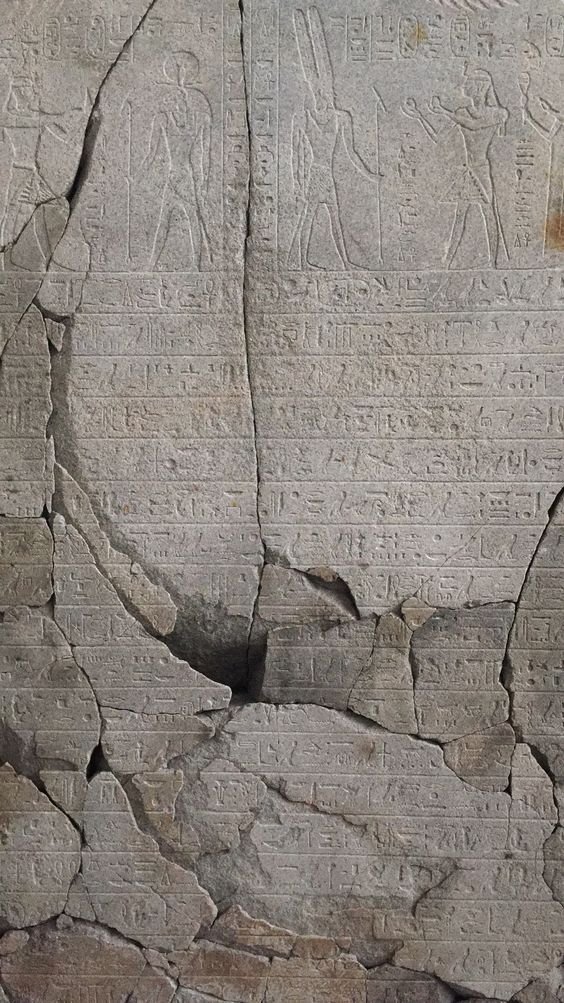
Let’s look at how he managed to achieve this endeavour. One of the key insights that Champollion had was recognizing that some hieroglyphic signs represented not just individual objects or sounds but also entire words or concepts. This is much like the concept of the Chinese characters, where often a single pictogram represents an entire concept. By comparing the Greek text on the Rosetta Stone with the corresponding Egyptian scripts, Champollion was able to identify patterns and correlations that allowed him to decipher the meanings of many hieroglyphic signs.
Champollion’s decipherment of hieroglyphs revolutionised the study of ancient Egypt, shedding new light on its history, religion, and culture. It enabled scholars to read and interpret a vast array of ancient texts and inscriptions, providing invaluable insights into the lives of the ancient Egyptians. They were able to understand the ideas, beliefs, society, religion and even day to day lives of the Ancient Egyptians. The significance of the Rosetta Stone extends far beyond its role in deciphering hieroglyphs. It serves as a tangible link to the past, connecting us with the ancient civilizations that once thrived along the banks of the Nile. This brings us to the real intrinsic meaning of the Rosetta stone’s inscriptions. The stone’s inscription, which commemorates the deeds of King Ptolemy V in 196 BCE, is important since it offers a glimpse into the political and cultural milieu of ancient Egypt during the Hellenistic period.
The inscription, etched into the surface of the Rosetta Stone, bears witness to a pivotal moment in ancient Egyptian history following the coronation of King Ptolemy V. Crafted as a decree, it served to formalise and elevate the divine cult surrounding the newly anointed ruler, embodying the fusion of Egyptian and Hellenistic traditions characteristic of the Ptolemaic era. This proclamation of divine kingship was not a unilateral decision but rather the outcome of a deliberative process conducted by a congress of esteemed priests convened at Memphis, the ancient capital of Lower Egypt.
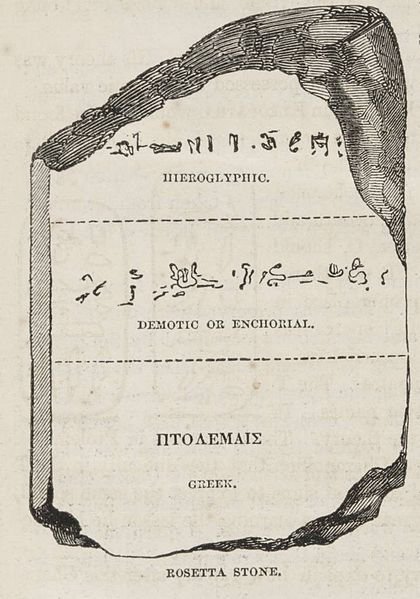
The precise dating of this decree adds a layer of historical richness to its significance. Recorded as “4 Xandikos” in the Macedonian calendar and “18 Mekhir” in the Egyptian calendar, the inscription pinpoints the momentous occasion to the 27th of March in the year 196 BCE. This dual dating reflects the cultural amalgamation inherent in Ptolemaic Egypt. It should be noted that Ptolemaic Egypt was a Hellenistic kingdom established by Ptolemy I Soter, one of Alexander the Great’s generals, following Alexander’s conquest of Egypt in 332 BCE. It endured for nearly three centuries until the death of Cleopatra VII in 30 BCE. Characterised by a fusion of Egyptian and Greek culture, Ptolemaic Egypt witnessed significant economic prosperity, cultural exchange, and intellectual development.
Coming back to the Rosetta stone, the decree inscribed on it emerged during a tumultuous era in Egyptian history, marked by political intrigue and upheaval. Ptolemy V Epiphanes ascended to the throne in 204 BCE at the tender age of five, following the untimely demise of both his parents, Ptolemy IV Philopator and Arsinoe. Their deaths, allegedly orchestrated by a conspiracy involving Ptolemy IV’s mistress Agathoclea, plunged Egypt into chaos. Agathoclea and her cohorts assumed control over the kingdom, acting as regents for the young ruler.

However, their oppressive regime sparked discontent among the populace, culminating in a revolt led by the general Tlepolemus just two years into Ptolemy V’s reign. In a dramatic turn of events, Agathoclea and her family met a violent end at the hands of an enraged mob in Alexandria, signalling the downfall of their tyranny. Tlepolemus, though initially hailed as a liberator, was swiftly replaced as guardian by Aristomenes of Alyzia in 201 BCE. Amidst this backdrop of instability and power struggles, Aristomenes took centre stage as chief minister and played a pivotal role in the issuance of the Memphis decree, which sought to consolidate Ptolemy V’s authority and divine status. The inherent value of the Rosetta stone itself is of much value in reconstructing Egyptian political history.
The decipherment of the Rosetta Stone not only revolutionised the study of ancient civilizations and languages but also showcased the efficacy of comparative linguistics. This breakthrough provided a blueprint for deciphering other enigmatic scripts and languages, such as cuneiform and Linear B. The methodologies developed in unravelling hieroglyphs have since been applied globally, enriching our understanding of diverse linguistic traditions. The Rosetta Stone’s decipherment remains a testament to human ingenuity and the enduring quest to unlock the mysteries of the past, leaving an indelible mark on the field of linguistics and archaeological studies.
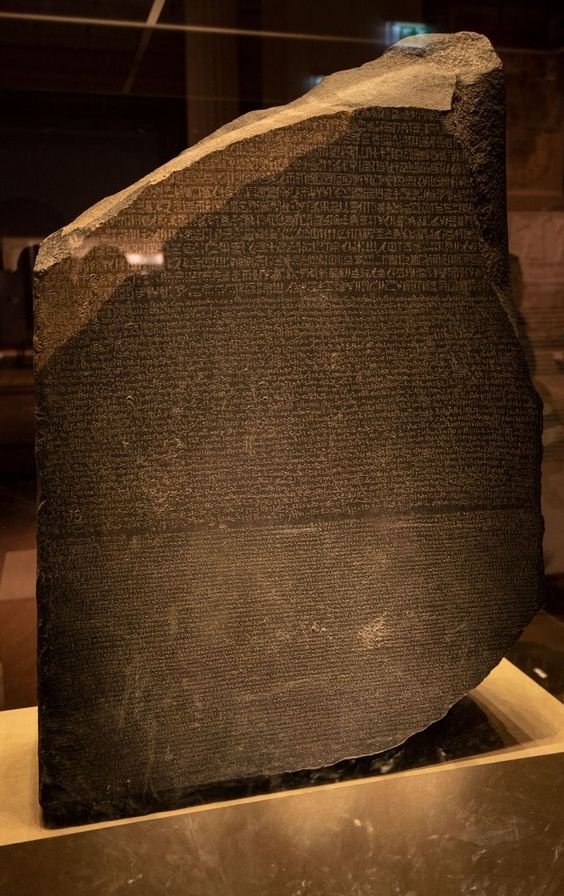
The impact of the Rosetta Stone extended far beyond academia, permeating into popular culture and igniting a phenomenon known as Egyptomania. This widespread fascination with ancient Egypt and its culture manifested across various aspects of society, leaving an indelible mark on Western culture. In the realm of art, the allure of ancient Egypt inspired countless artists to incorporate Egyptian motifs, themes, and symbolism into their works. Paintings, sculptures, and decorative arts featuring pharaohs, pyramids, hieroglyphs, and Egyptian deities became increasingly popular, reflecting society’s fascination with the exotic and mysterious world of ancient Egypt.
Likewise, literature also embraced Egyptomania, with authors incorporating Egyptian themes and settings into their novels, poems, and plays. From adventure stories set amidst the sands of the desert to romantic tales of forbidden love in the shadow of the Sphinx, literature provided an escape into the enchanting world of ancient Egypt. Egyptomania also left its mark on fashion and design, with Egyptian-inspired clothing, jewellery, and accessories becoming fashionable trends. From flowing tunics adorned with hieroglyphic motifs to intricately crafted beetle amulets, the allure of ancient Egypt permeated through fashion, offering a sense of exoticism and sophistication.
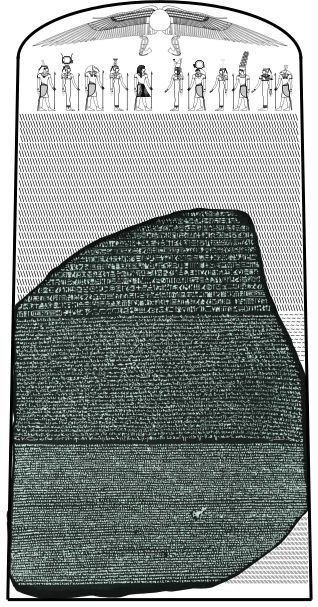
Egyptomania has also captivated filmmakers throughout the ages. From epic adventures set amidst the sands of the desert to mystical tales of pharaohs and mummies, the fascination with Egypt has manifested in a diverse array of cinematic productions. One of the most iconic examples of Egyptomania in cinema is the classic film “The Mummy” (1932), directed by Karl Freund and starring Boris Karloff. This groundbreaking horror film introduced audiences to the chilling tale of an ancient Egyptian priest, Imhotep, who is resurrected and seeks revenge upon those who desecrated his tomb. Today, its 1999 adaptation starring Brendan Fraser is more popular and continues to captivate audiences with their thrilling portrayals of ancient Egyptian curses and supernatural phenomena.
In summary, the discovery of the Rosetta Stone had a transformative impact on our understanding of ancient history, linguistics, and archaeology. Its decipherment revolutionised the study of ancient Egypt, opened up new avenues for linguistic research, inspired cultural fascination with the ancient world, and fueled archaeological exploration and discovery. The Rosetta Stone remains one of the most iconic artefacts in the study of ancient civilizations, symbolising the enduring quest for knowledge and understanding of the past.
Today, the Rosetta Stone is housed in the British Museum in London, where it continues to captivate visitors from around the world. Its significance as a symbol of linguistic and cultural discovery remains undiminished, reminding us of the power of human curiosity and ingenuity in unlocking the secrets of the past.
